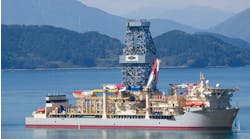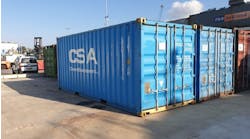Nick Terdre
Contributing Editor
Impression of Statoil's floating LNG plant offloading to a gas carrier.Statoil is developing a new concept for the offshore loading of liquefied natural gas (LNG) which brings an important step closer the harvesting of stranded gas reserves in places like Australia. A pre-feasibility study has shown that offshore cryogenic loading (OCL) is feasible, and the producer is designing and qualifying the critical components.
This engineering phase will run until next spring, followed by qualification modeling tests. The tests should be completed by about mid-2000, according to Bjorn Sparby, Project Manager in gas business development.
The concept, aroused interest when it was presented at a conference in Perth earlier this year. Statoil subsidiaries - Navion, Framo Engineering, Seaflex, and Advanced Production and Loading - also participated in its development.
During transfer from the production unit to a transport vessel, the temperature of the LNG has to be maintained at -163°C to prevent vaporization. This is achieved by means of a vacuum-insulated corrugated pipe, which allows the overall diameter of the transfer hose to be much reduced, compared with other insulation methods. For an 8-in internal diameter pipe, a vacuum insulated corrugated pipe would have an external diameter of 12 in., compared with up to 20 in. for other methods, Sparby says.
During loading, the production unit and gas carrier would be lined up in tandem, with two transfer hoses running from the stern of the production vessel to the bow of the carrier some 45-55 meters away. A semi-stiff sea fastening system has been developed by Navion to ensure that the two vessels would not collide.
The offloading technology complements the proprietary multi-fluid cascade process developed by Statoil and Linde for use on floaters. The process uses plate-fin and/or spiral-wound heat exchangers of reduced size and complexity, which are less sensitive to ship's motions. Another feature is columns designed with packings to reduce their height and vulnerability to ship's motions.
The LNG production vessel would have a capacity of some 3.5 MMtpy of LNG. Carrying a topside weight of 15,000 tons, the vessel would be very large, with a length of 320-340 meters and width of 60 meters.
But its production capacity would be substantially less than that of the typical land-based liquefaction plant, and this could give marketing advantages, such as being able to sell smaller volumes and not having to coordinate sales with a large number of customers to make production operations viable, Sparby says.
Statoil strikes Vietnam LPG distribution deal
Statoil plans to become involved in the downstream bottling and distribution of liquefied petroleum gas (LPG) in Vietnam. A deal was signed in May whereby the company will hold a 57% stake in Mekong Gas, along with PetroVietnam Oil Processing and Distribution, a subsidiary of state oil company PetroVietnam, and Mekonimex.In the first stage, about $10 million will be invested in an LPG terminal and bottling plant with a capacity of 10,000 tons/year to be located at Can Tho in the Mekong delta. Operations are expected to begin in about a year's time, according to Statoil vice president Tore Sund, the company's chief representative in Vietnam.
The market for LPG, which is used mainly for domestic cooking, is small but growing fast, Sund says. At present supplies are imported, but Mekong Gas aims to source its supplies locally as the country's offshore gas and condensate reserves are brought onstream.
Statoil sees the potential for further downstream gas-based developments in which it could participate, and is discussing a wide range of opportunities, says Sund, who expects the company to become involved in setting up further projects with Vietnam partners over the next year or so.
The LPG initiative marks Statoil's first step into developing activities in Vietnam outside the scope of its alliance with BP, which currently is planning the development of offshore gas reserves in the Lan Tay and Lan Do fields and their use in power generation.
Terms are still being negotiated, both for the gas field development and a planned power plant. No time-scale exists for finalizing these negotiations, according to Olav Heigre, deputy director general for the Statoil/BP alliance in Vietnam.
However, once this stage is reached, and construction contracts awarded, it will take a little over two years to develop the gas fields, pipeline to shore and processing terminal. Gas and condensate will be produced at a rate of 7-8 MMcm/d through subsea wells tied back to a processing platform.
Statoil currently holds a 15% interest in the two fields, BP 30%, and their partner, the foreign arm of India's state company ONGC, 55%. When the development stage is reached, state company PetroVietnam has an option to take up to 5%.
Plans call for the gas from the two fields to be used in two other power plants, in addition to the one in which Statoil and BP will have a stake. The two companies are also involved in proposals for establishing a urea/ammonia plant using gas as feedstock, but a source of gas supplies for this facility has yet to be determined, says Heigre.
Copyright 1998 Oil & Gas Journal. All Rights Reserved.




